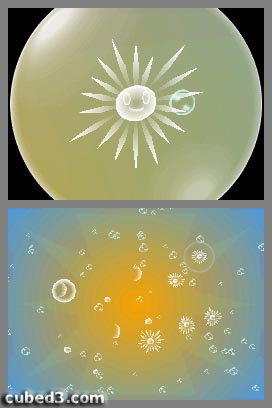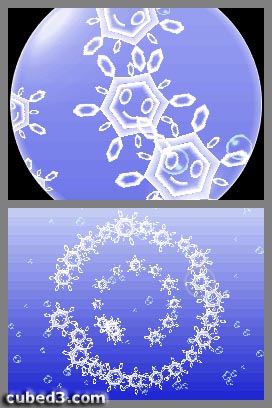Electroplankton (Nintendo DS) Review
By Mike Mason  04.07.2006
04.07.2006

There was a time when it seemed unlikely that Electroplankton would ever see the light of day outside of its home nation of Japan. Afterall, what demand is there for a title about musical marine-life in the world if there is none in Japan, a territory that accepts some of the strangest titles? However, it's squirmed itself off the hook that stopped it swimming to other places - the plankton will be in a river near you very soon...
This is it then, one of the final two Touch Generation titles to land in the west for a little while (the other being Big Brain Academy). When Toshio Iwai, Japanese audio-visual multimedia artist extraordinaire, set his eyes on DS it was only a matter of time before he came up with something to exploit the touch screen. Iwai had previously worked on Nintendo consoles back in the times of the NES, creating Otocky (a musical shoot 'em up) for the Japan-only Famicom Disk System, and on Sound Fantasy for the SNES (which was unfortunately cancelled and ended up becoming SimTunes on PC). The addition of a touch screen to a video game system proved too intriguing for the artist, who succumbed to its charms and created a title that aims to similarly charm everybody who plays.
Electroplankton is a title that revolves around users experimenting and creating interesting, sometimes beautiful, sounds. This is done by selecting one of ten different species of fish and manipulating them and their environments with your stylus to get the sounds and music that you want. Each fish is painted with a friendly face, seemingly encouraging all and sundry to go ahead and touch them.
Switch on the title, and you will be presented with a simple menu with just two options: performance mode and audience mode. In the latter, Electroplankton randomly selects one of its fishes and plays you a variety of music for as long as you like without you having to do anything - very relaxing after a long day. The former, though, is where the main meat of the software is. Here, you get to grips with the plankton yourself - and there’s a nice variety of them.

Each plankton uses the touch screen in some way, and a few use the microphone as well. It's easiest to go through them in some semblance of order: Tracy asks you to draw out paths for four fish. The fish then follow the set paths repeatedly and produce a different sound depending on which part of the screen the paths have been drawn on. If you draw a short line, then the loop will be shorter, and the speed is also altered depending upon how quickly or slowly you draw your path. There is a limited distance the path can be, but within that limit you can draw whatever you like. Yes, even rude things. Next up is Hanenbow, a leaping fish that is launched from a leaf into the sea. The speed at which they are launched can be altered, and as they career towards the water they can come into contact with leaves to create sounds. These leaves can be moved about by users, and vary from few to many - the amount can be changed by pressing ‘select’ to show a new setting. Luminaria is a plankton that lends itself to slightly more conventional music making, with four different-sounding glowing aquatic creatures sitting in each corner of the screen, waiting to be tapped and set off on their movement, which follows arrows – the screen is full of them. Once they move, you can tap the arrows to turn them, thus changing the paths of the plankton, allowing them to reach high and low notes (which, as with Tracy, are produced by having the fish touch separate parts of the screen).

Those already mentioned are perhaps the most complex to describe. Others include Sun-Animalcule, small creatures that are brought to existence with a tap of your stylus. The mode slowly cycles between day and night, and the plankton slowly grow and make different sounds according to their placement and the time of day. As they grow larger, they get noisier until...pop! Time to create a new one...or you could move onto Nanocarp, one of the more random entries, with a bunch of formation changing fish that alter their positioning according to what you do, including what sounds you make into the microphone. Marine-Snow is also a little difficult to make 'proper' music on, as when you tap a snowflake plankton it emits a sound and then switches position with the next one you press, meaning it can be difficult to keep track of all the notes that you want to use. It can be very fun to just run your stylus over them though and listen to what you get! Lumiloop requires you to spin circles on the touch screens at any pace or direction you want to create assorted music, on five doughnut-like fish. Rec-Rec is a delve back towards the more conventional again, basically being a four track sampler - tap each fish and you can record a ten second clip on each one of them. This can be excellent fun, and the sky’s the limit to what you want to put in. Beatnes plays classic tracks from NES games in the background and allows you to tap assorted segments of skeletal plankton to create a medley of sound effects from the game which has its background music playing. Finally, and perhaps the most accessible, is the voice sampler Volvoice. Record whatever you want through the microphone, then alter it however you want with the buttons around the plankton (which gets fatter the more you record on it). You’ll have to excuse us for being immature on this one. Very immature.

If a prerequisite for you being interested in a piece of software is having the ‘amazing visuals’ box ticked, you might as well walk away. While not bad to look at, Electroplankton’s visuals are fairly simplistic, with the creatures drawn simply with gormless expressions (which, to be fair, are probably warranted due to the traditionally small fishy mind) and the environment only moving with occasional waves or splashes from the fish. All this is fair enough, considering that it was developed by Toshio Iwai only. The lack of graphical prowess allows you to focus upon the real highlight of Electroplankton - the audio spread, and what a spread it is. All the samples are wonderful, and it’s literally impossible to create an atrocious sounding piece in some of the modes; you’d think Beatnes would be a mess waiting to happen, but it never comes anywhere close to it. The quality of the samples is high too, and there’s vast potential for music making, as proven by some of the more experimental DJs - you may remember David Hollands performing at Nintendo’s E3 press conference in 2005, who used multiple DSes in conjunction with a mixing desk to create a piece of music (for those of you who don’t remember, you can find more information here).
There is a big potential flaw with Electroplankton, and that is the lack of a save function. However, it could be put down to the title being more about messing about rather than creating masterpieces that can be called up on a whim. Randomness, on the spot ingenuity, luck and coincidence are the main focuses, and this spontaneity would be swiped away with the addition of a save function. This is one way of looking at it, but it’s sure that others will not want to be bothered with the hassle of hooking the DS up to a computer to record their pieces, and the lack of the save will be a definite downfall for them - it’s only fair that you’re warned.
By now you may have noticed that we have yet to refer to Electroplankton as a game, and this is wholly intentional. Electroplankton is not a game, it is a tool of experimentation, with no objective, no goals, no rewards for doing well, no punishment for doing anything wrong; in fact, there is no right or wrong at all. Many gamers would give the ‘free’ label to a game such as Grand Theft Auto, or the Elder Scrolls series, but in reality they are not, having rules in place that cannot be ignored, no matter how loose they often are in comparison to other games. Electroplankton, though, is fully deserving of being described as ‘free’, as you can do anything you want - your imagination is the only limit to what shape your creations take. It probably won’t keep you playing for hours at a time every day, but it’s nice to be able to pop on it for a quick session regularly, as there’s never a shortage of music that you can make.
Nintendo are tragically expecting very little of the game, and so haven’t advertised it, save for a tiny spot in the latest DS Lite commercials. Don’t follow their example, don’t ignore Electroplankton, at least give it a try. It’s another hugely inventive title for DS that deserves more success than it’s already had. It’s far more interesting than having a pet goldfish, and the only other fish on a game system that is potentially more fun is Vivarium’s Seaman.

Cubed3 Rating
Great - Silver Award

It's instantly accessible and is just the kind of title Nintendo need in their Touch Generation line up. With demo stands, this would probably make it into the charts, but unfortunately this doesn't seem to be on the cards, so we're just going to have to depend upon sensible people like yourselves to hop off and buy it. Easily another title worthy of a place in any DS collection, but wary that it is more of a toy than a game - but what a toy it is.
Comments
Comments are currently disabled

 Sign In
Sign In Game Details
Game Details
 Out now
Out now  Out now
Out now  Out now
Out now  Out now
Out now  Subscribe to this topic
Subscribe to this topic Features
Features





 Top
Top

